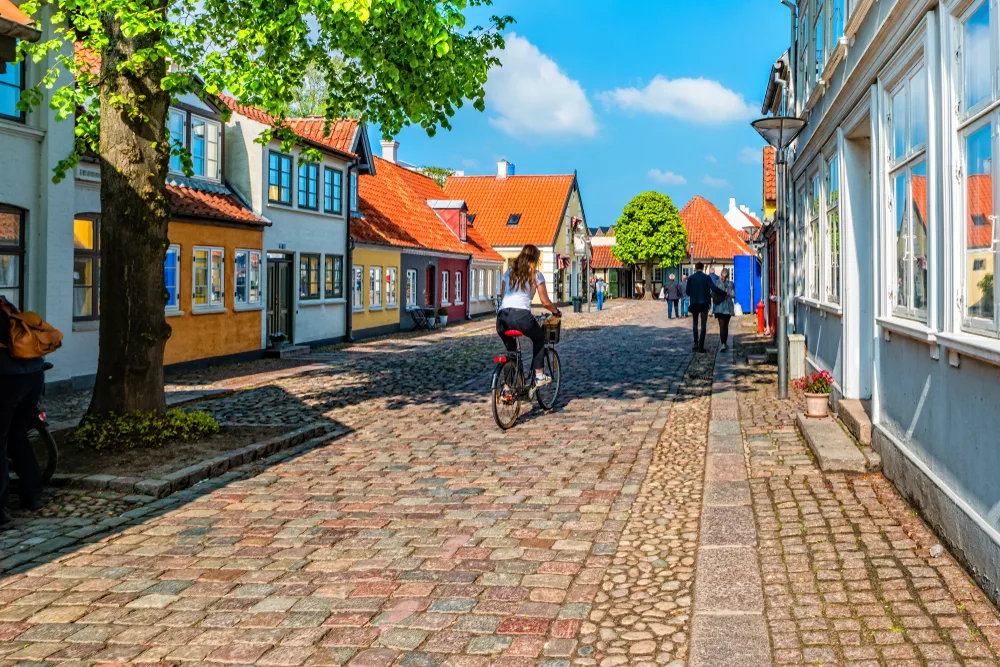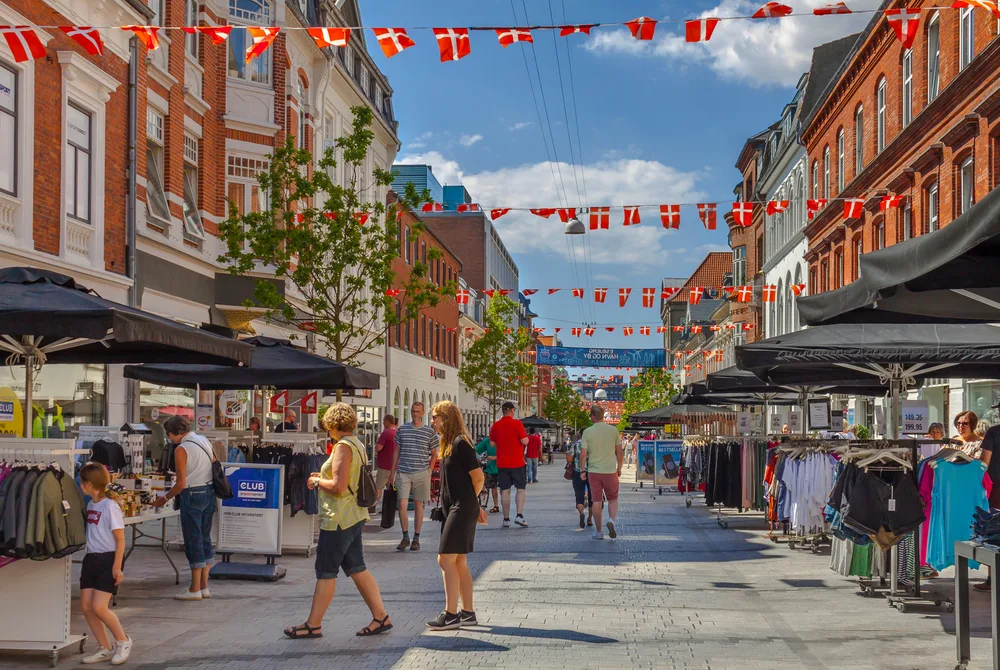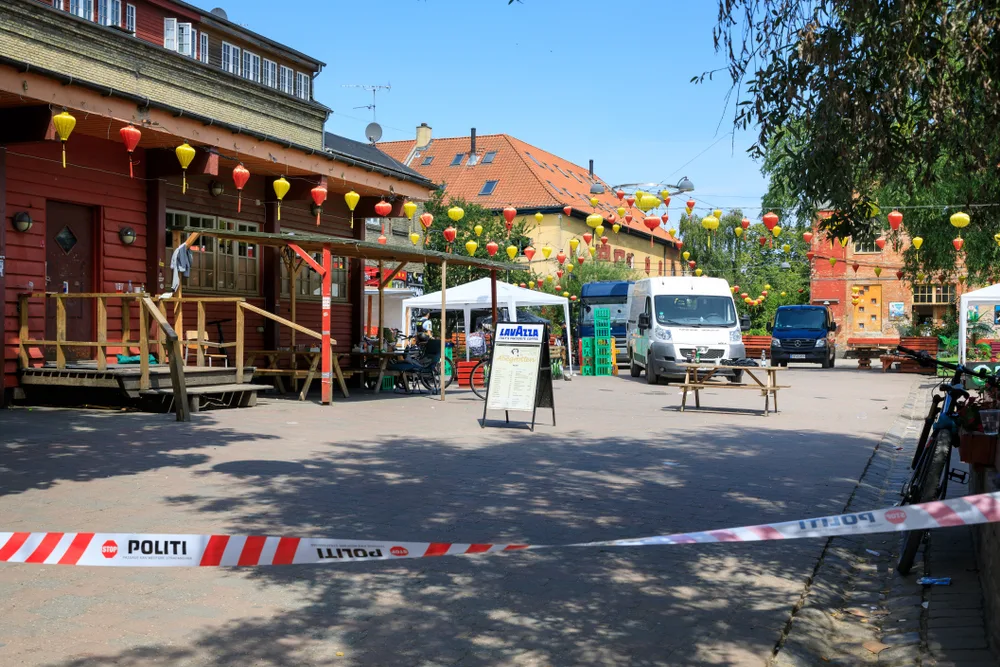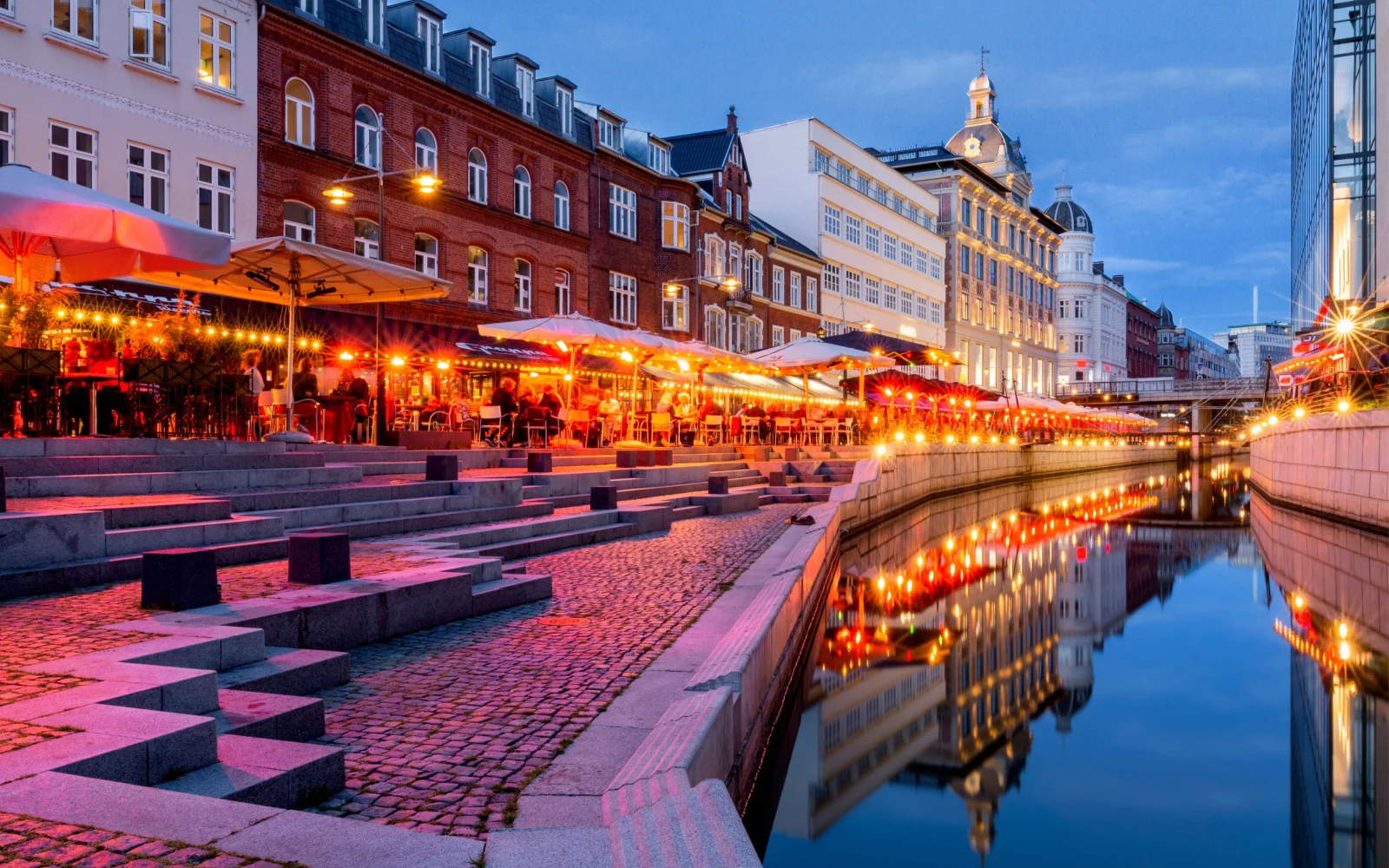The Scandinavian country of Denmark is very popular with tourists. In 2019, the country recorded over 33 million international visitors.
Most visitors spend at least a few days in Copenhagen, the capital, exploring its beautiful architecture, forward-thinking design, and bohemian nightlife.
Other popular towns in Denmark are Aarhus, a hub of design and culture, and Odense, the hometown of Hans Christian Andersen. You can also get into nature by exploring the country’s many islands or the wild, sandy coast.
While the city is a beautiful place to visit, that doesn’t mean you should book your trip right away. You should always research potential destinations before traveling, especially safety concerns.
But don’t worry — our travel experts have done the hard work for you. Keep reading to learn more about traveling to the country safely, including crime information. Let us be your guide!
Is Denmark Safe to Visit?

Perekotypole/Shutterstock
Yes. Denmark is generally a very safe country to visit. The country has a low crime rate that is practically non-existent outside of the biggest cities.
Although the risks of incidents such as pickpocketing are present, danger for tourists is rare. A good place to start researching any country you might want to visit is travel advisories issued from your government or other governments.
These travel advisories contain detailed information about potential risks facing tourists, from natural disasters to crime. Just keep in mind that countries need to keep their citizens safe, so they always include the worst case scenarios which are not always the most likely scenarios.
The United States issues a Level Two travel advisory for Denmark. According to the State Department, American citizens should exercise increased caution due to an elevated risk of terrorism.
However, not all countries agree with this assessment. For example, Australia only issues a Level One travel advisory for Denmark. It just advises its citizens (or all interested parties) to take basic precautions, the same as they would at home.
Common problems you might encounter in Denmark include:
- Pickpocketing
- Bag snatching
- Theft of unattended items
- Tourist scams
- Drug and alcohol-related crimes
- Assault
Violent crime is rare, although tourists have been caught in the wrong place at the wrong time before. Protests and demonstrations sometimes happen, especially in the capital Copenhagen.
The vast majority of protests are non-violent. However, the situation can sometimes escalate, so it’s best to stay away from large crowds of demonstrators if you are a foreigner to avoid getting caught up in some mischief.
Many people who visit Denmark love to explore Danish nature as well as the cities. Activities such as wild camping are popular with locals and visitors alike.
Whenever you head into nature, remember to take basic safety precautions such as choosing activities appropriate for your skill level, checking the weather forecast ahead of time, bringing necessary supplies, and always letting someone know where you are.
Denmark has many beaches, including hundreds of Blue Flag beaches that signal that the water meets environmental and cleanliness standards. The North Sea can sometimes get rough (and the water is fairly cold) so be careful and try to swim only at beaches that have lifeguards on duty.
Crime in Denmark

Esbjerg, Syddanmark / Denmark — 05.22.2018: View of Kongensgade the longest shopping street in Esbjerg and one of the longest in Denmark/ERYK7021/Shutterstock
For many tourists, crime is one of their primary concerns when visiting a new place. After all, nobody wants to be the victim of a new crime in a foreign place where you don’t know how to report a crime to the police (and may not even speak the same language).
You also don’t want to be in a situation where you can’t easily replace your credit card, and don’t have familiar people around you to support you through a traumatic event. And we’re here to help.
Researching crime statistics for a new place, such as Denmark, can help you gain peace of mind about your travels or at least know what you are signing up for.
A look at Denmark’s crime statistics quickly shows you that the country is a safe place to visit. It has a low overall crime rate and an exceptionally low violent crime rate.
The homicide rate is just 0.95 incidents per 100,000 people, which is far below the global average. Homicides are indicative of violent crime trends as a whole, so this shows that Denmark overall has a low violent crime rate.
According to official Danish government statistics, there were 116,023 total offenses reported in the first quarter of 2023 (this includes crimes as well as minor offenses). Breaking down the crimes committed in this quarter can show us more about trends in Danish crime.
Violent crimes made up 5.9% of total offenses committed. The most common violent crime was assault, which made up 37.6% of total crimes committed.
Keep in mind that unlike many governments, the Danish government treats sexual crimes as a separate category instead of lumping them in with other violent crimes. Property crimes made up 59% of total crimes and offenses reported in Denmark.
The most common forms of property crime were various forms of theft, fraud, and property damage. There are a few reasons why the violent crime rate is so low.
Societal factors that push people towards crime such as unemployment and income inequality are fairly low (although Danish society is still heavily racially segregated and immigrants often complain that they are targeted by police).
Denmark also has a low presence of organized crime, although street gangs including biker gangs are increasing their ties with criminal activity. These gangs are behind a rise in violent crime in some of Denmark’s urban areas.
While the city certainly has its problems, they are not nearly as present as they are in some other countries. Plus, most tourists are insulated from the vast majority of crimes in the country besides petty theft.
Petty Theft
The most likely crime you will encounter as a visitor in Denmark is petty theft. Most governments mention it in their travel advisory, such as the UK government.
Petty theft is most common in big cities such as Copenhagen. However, it can happen anywhere, so it’s a good idea to be on your guard.
Hotspots for theft include popular tourist areas such as Christiania and Nyhavn in Copenhagen, transportation hubs such as airports and train stations, public transportation, and inter-city trains.
Basically, wherever there are large crowds and plenty of visitors, there are probably pickpockets.
The Canadian government warns its citizens not to let their guard down against pickpockets as they are common in unexpected areas where people might get lulled into a feeling of safety, such as hotel lobbies and restaurants.
Thieves often blend in with patrons to take advantage of loose-hanging purses and coats.
Basic precautions are smart enough to deter most Danish thieves. Make sure that you never leave your things unattended as theft from unattended items, such as luggage stored in luggage racks, is common.
Put your valuables in a place that is hard to reach without you noticing — that means no wallets in back pockets while on public transportation.
You should also be on your guard if you notice someone trying too hard to interact with you on the street. Thieves often work in groups. Someone will distract a mark, while another person takes the victim’s valuables.
Be careful of common scams such as someone spilling something on you and offering to clean it up or asking you to sign a petition.
Terrorism
Terrorism is one of the most commonly-cited dangers in travel advisories for Denmark. For example, New Zealand cites terrorism as the reason why it issued a Level Two travel advisory for Denmark.
There is a risk of terrorism in most European countries, including Denmark. Terrorists come from a few different backgrounds.
There is a threat of radical Islamist terrorism as some terror plots have been linked to ISIS/Daesh and returning militants from the Middle East. The city is also seeing a rise in far right terrorism, often targeting minority communities.
There have been some high-profile terrorist attacks in recent years. In 2022, there was a shooting at a mall in Copenhagen, although the suspect was not immediately linked to terrorist motives.
In 2015, there were also dual attacks in Copenhagen. However, keep in mind that these are the only two terrorist incidents in Denmark in the past decade (and one incident was not even confirmed as a terrorist attack).
The Danish authorities have foiled several other attempts, but these are the only ones that actually were carried out. Although tourists can always get unlucky, the likelihood of a terrorist attack happening while you are there is very low.
You don’t need to be on constant guard against terrorism, but some precautions may help put your mind at ease. Follow local news or Danish government advisories about the terrorism risk.
Be alert in crowded areas and places that might be targets, such as government buildings. Trust your instincts and if something feels unsafe, get away.
Avoiding Bad Areas

Copenhagen, Denmark – July 12 2019: Police raid in the free city of Christiania/Konstantin Tronin/Shutterstock
Most seedy areas in Denmark are located in Copenhagen, the biggest city. Christiania, an autonomous anarchist community, is a popular tourist destination in Copenhagen.
However, in recent months it has seen an uptick in gang activity that is troubling local residents, so avoid going after nightfall.
The community has its own rules that are strictly enforced (sometimes through fistfights), so make sure you follow the rules and don’t take photographs. Some neighborhoods in Copenhagen have high rates of street gang activity.
Avoid places such as Norrebro, Husum, and Amager Island, especially at night. Aalborg is a Danish city with a fairly high crime rate, but also not many tourist attractions so most visitors don’t venture there.
Things to Consider
Here are a few additional safety tips to consider on a trip to Denmark:
- Make sure that you buy a ticket for public transportation. Hold on to your ticket throughout your ride. Conductors apply random ticket checks and fines for not buying a ticket are very high.
- Obey local laws. Although some parts of Copenhagen such as Christiania have a very liberal attitude towards drugs, drugs such as cannabis are highly illegal in Denmark. Penalties are severe, and foreigners have been caught before.
- Be careful when traveling to the Arctic. Danish territories such as Greenland and the Faroe Islands are popular destinations for nature lovers. If you are going there, pack warm clothing and take precautions against cold weather. Make sure you don’t venture away from organized tours or marked paths as cell phone coverage is minimal and rescue operations are costly.
- Remember cyclists! Even if you aren’t cycling, keep an eye out for bicycles while walking or driving. Stay out of cycle lanes and keep in mind that cyclists often have the right of way.
Frequently Asked Questions

ABB Photo/Shutterstock
Here are a few other questions visitors to Denmark have asked in the past:
Is it safe to go to Denmark?
Yes, it is safe to go to Denmark. There is some risk of petty crimes such as pickpocketing or more major incidents such as terrorism, but the risk overall is fairly low.
How safe is Copenhagen for tourists?
Denmark’s capital Copenhagen is very safe for tourists. It has a fairly low crime rate and great infrastructure for tourists.
Is it safe to walk at night in Copenhagen?
Copenhagen is even safe for tourists after dark. As long as you avoid certain neighborhoods with a reputation for violent crime, you can safely walk at night in Copenhagen. In fact, you should do so during your visit as one of the best things to do in Copenhagen is to explore the nightlife!
What level of terror threat is Denmark?
According to local advisories, there is a significant terror threat to Denmark (level four out of five according to the government’s system). However, this just means the government is monitoring the situation, not that an attack will happen.
Can you speak English in Denmark?
Yes, you can speak English in Denmark. Although the official language is Danish, most people speak English.
So, Should You Take Trip to Denmark?
Denmark is one of the safest countries to visit in Europe. It has a very low crime rate, and as long as you take basic precautions, you should have a safe trip!



